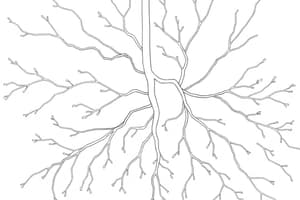Podcast
Questions and Answers
Il sistema linfatico è coinvolto unicamente nelle risposte immunitarie innate.
Il sistema linfatico è coinvolto unicamente nelle risposte immunitarie innate.
False (B)
Il linfedema è caratterizzato da un gonfiore degli arti, di solito causato da un eccesso di fluido nei vasi sanguigni.
Il linfedema è caratterizzato da un gonfiore degli arti, di solito causato da un eccesso di fluido nei vasi sanguigni.
False (B)
Il sistema linfatico non ha alcun ruolo nel mantenimento dell'equilibrio dei fluidi nel corpo.
Il sistema linfatico non ha alcun ruolo nel mantenimento dell'equilibrio dei fluidi nel corpo.
False (B)
I linfociti maturano e si replicano nei tessuti e negli organi cardiovascolari.
I linfociti maturano e si replicano nei tessuti e negli organi cardiovascolari.
La filariasi linfatica, conosciuta anche come elefantiasi, è una malattia causata da un batterio che colpisce specificamente i vasi linfatici.
La filariasi linfatica, conosciuta anche come elefantiasi, è una malattia causata da un batterio che colpisce specificamente i vasi linfatici.
I vasi linfatici hanno delle valvole bidirezionali, assicurando che la linfa possa fluire in entrambe le direzioni.
I vasi linfatici hanno delle valvole bidirezionali, assicurando che la linfa possa fluire in entrambe le direzioni.
La linfa si forma dal fluido intracellulare all'interno delle cellule.
La linfa si forma dal fluido intracellulare all'interno delle cellule.
I linfonodi sono principalmente responsabili della produzione di globuli rossi, essenziali per il trasporto di ossigeno.
I linfonodi sono principalmente responsabili della produzione di globuli rossi, essenziali per il trasporto di ossigeno.
I capillari linfatici sono vasi aperti che permettono al fluido di entrare e uscire liberamente.
I capillari linfatici sono vasi aperti che permettono al fluido di entrare e uscire liberamente.
La contrazione dei muscoli circostanti aiuta a spingere la linfa attraverso i vasi linfatici.
La contrazione dei muscoli circostanti aiuta a spingere la linfa attraverso i vasi linfatici.
Il timo è un organo linfoide di fondamentale importanza per lo sviluppo dei linfociti B.
Il timo è un organo linfoide di fondamentale importanza per lo sviluppo dei linfociti B.
Le tonsille e le adenoidi sono organi linfatici situati nell'addome, che filtrano il sangue.
Le tonsille e le adenoidi sono organi linfatici situati nell'addome, che filtrano il sangue.
Le placche di Peyer sono tessuti linfatici localizzati nel fegato, con funzioni simili ai linfonodi.
Le placche di Peyer sono tessuti linfatici localizzati nel fegato, con funzioni simili ai linfonodi.
Flashcards
Sistema linfatico
Sistema linfatico
Sistema di vasi, tessuti e organi che trasporta la linfa, un fluido contenente globuli bianchi, in tutto il corpo.
Linfa
Linfa
Fluido che scorre nel sistema linfatico, composto da liquido interstiziale e globuli bianchi.
Capillari linfatici
Capillari linfatici
Piccoli vasi che raccolgono il liquido interstiziale e lo trasportano verso i vasi linfatici più grandi.
Linfonodi
Linfonodi
Signup and view all the flashcards
Linfociti
Linfociti
Signup and view all the flashcards
Milza
Milza
Signup and view all the flashcards
Timo
Timo
Signup and view all the flashcards
Placche di Peyer
Placche di Peyer
Signup and view all the flashcards
Che cos'è il linfedema?
Che cos'è il linfedema?
Signup and view all the flashcards
Qual è il ruolo del sistema linfatico nell'equilibrio dei fluidi?
Qual è il ruolo del sistema linfatico nell'equilibrio dei fluidi?
Signup and view all the flashcards
Come interagiscono i linfociti con il sistema linfatico?
Come interagiscono i linfociti con il sistema linfatico?
Signup and view all the flashcards
Quali malattie colpiscono il sistema linfatico?
Quali malattie colpiscono il sistema linfatico?
Signup and view all the flashcards
Qual è il ruolo del sistema linfatico nel sistema immunitario?
Qual è il ruolo del sistema linfatico nel sistema immunitario?
Signup and view all the flashcards
Study Notes
Structure and Function
- The lymphatic system is a network of vessels, tissues, and organs that transports lymph, a fluid containing white blood cells, throughout the body.
- It plays a crucial role in maintaining fluid balance, absorbing fats, and defending against infection.
- Lymph vessels have one-way valves, ensuring lymph flows towards the heart.
- Lymph is formed from interstitial fluid (fluid surrounding cells).
- Lymph nodes, small, bean-shaped structures, are strategically located along lymph vessels.
- Lymph nodes act as filters, trapping pathogens and cellular debris.
- Lymphocytes, crucial white blood cells, mature and proliferate within lymph nodes.
- Lymph transports these lymphocytes to various parts of the body to help fight infections.
Lymphatic Vessels
- Lymphatic capillaries are the smallest vessels in the lymphatic system.
- They are closed-ended tubes, unlike blood capillaries.
- They have very thin walls that allow interstitial fluid to easily enter.
- Lymph capillaries merge into larger lymphatic vessels, which progressively increase in size.
- Lymphatic vessels also contain valves to prevent backflow of lymph.
- Lymph is propelled through the vessels by the contraction of surrounding muscles.
- Lymph vessels ultimately drain into large veins near the heart.
Lymphatic Organs
- Lymph nodes are crucial for immune responses.
- They house lymphocytes and macrophages, cells crucial for fighting pathogens.
- Spleen is an important lymphatic organ, filtering blood and housing lymphocytes.
- Spleen stores blood and removes old red blood cells.
- Thymus plays a vital role in the development of T lymphocytes (a type of white blood cell).
- Lymph nodes, spleen, and thymus are considered primary lymphatic organs.
- Tonsils and adenoids are lymphatic tissues located in the mouth and throat area. They trap pathogens entering the body through the respiratory tract.
- Peyer's patches are lymphatic tissue located in the wall of the small intestine. They help capture/monitor pathogens or antigens that enter the body through the digestive system.
Immune Function
- The lymphatic system is deeply intertwined with the immune system.
- Lymphocytes, a type of white blood cell, play a critical role in immune responses.
- Lymphocytes, including B cells and T cells, recognize and target specific pathogens.
- Antigens stimulate the activation of these lymphocytes for an immune response.
- The lymphatic system plays a role in both innate (non-specific) and acquired (specific) immune responses.
- The lymphatic system helps clear cellular debris and pathogens, promoting healing.
Lymphedema
- Lymphedema is a condition characterized by swelling in the limbs, usually caused by damage or blockage of lymphatic vessels.
- A build-up of interstitial fluid accumulates due to a disruption in lymphatic fluid transport.
- Various factors can lead to lymphedema, including cancer treatments, surgeries, injuries and infections.
Fluid Balance
- The lymphatic system plays a significant role in maintaining fluid balance in the body.
- It absorbs interstitial fluid, preventing fluid buildup in tissues.
- This prevents edema (tissue swelling).
- By returning this fluid to the bloodstream, it prevents fluid from accumulating around the body's cells.
- The lymphatic system works in coordination with the circulatory system.
Immune Cell Activity
- Lymphocytes (B cells and T cells) mature and proliferate in lymphatic tissues and organs.
- These lymphocytes recognize antigens and mount specific immune responses.
- The lymph nodes act as crucial sites for immune cell activation and communication.
- Actively involved in the immune response to fight off foreign substances.
Diseases Affecting the Lymphatic System
- Lymphatic filariasis, also known as elephantiasis, is a parasitic disease that specifically affects the lymphatic vessels.
- Lymphoma is a cancer that develops in the lymphatic system.
- Other lymphatic disorders can cause a variety of complications or symptoms involving the immune system and fluid flow.
Studying That Suits You
Use AI to generate personalized quizzes and flashcards to suit your learning preferences.




